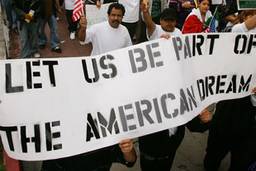
Sherrie Hetherington graduated from the Seattle-area Highline Community College this year with thousands in sticky debt, but she counts herself among the lucky. The 27-year-old mother of two nearly left school in her last semester because her financial aid was cut off and she was forced to take out a $3,500 loan, which she fears may break her family’s budget.
“If you don’t get employment—and who knows in this economy—you’re stuck.” Still, she says, “I feel good I graduated. They said over 500 people couldn’t participate in the ceremony because they didn’t meet the requirements or had financial aid problems.”
Critical shortcomings in the nation’s financial aid system will put higher education out of reach for millions of well-
prepared, low-income high school graduates by the decade’s end. And for later-life students like Sherrie, few resources are available.
The trends look bad: Budget-crunched states are cutting back and abandoning their commitment to need-based aid, federal financial aid continues to lag behind tuition costs, and graduates’ average debt load keeps rising. Grant aid has dropped steadily while loan burdens have increased by 135 percent in the last decade and now make up two-thirds of all financial aid, according to a Congressional Joint Economic Committee study. Seventeen states cut spending on financial aid this year, some by as much as a quarter, while tuition and fees rose in every state.
As a result, nearly half of all qualified low- and moderate-income high school graduates did not enroll in four-year schools last year. Over the course of the decade, the Congress-appointed Advisory Committee on Student Financial Aid estimates, two million students prepared for college simply will not go.
President George W. Bush’s response to these disturbing trends has been to blame colleges for ballooning educational costs. Although last year’s federal budget boosted the Pell grant program, Washington’s biggest source of aid to poor students, this will only enable more students to receive the grant, not increase its size. Meanwhile, the grant’s purchasing power eroded significantly over the past decades. It now pays for less than half the cost of attending a public four-year school; in 1975, it paid for 84 percent. The federal Department of Education recently tightened eligibility criteria for the grant, sure to cause the middle-income families affected to demand relief, which will come invariably at the expense of their more needy neighbors.
Tuition inflation is a problem, but only one root of the issue. Tuition hikes at most private schools in the 1990s were in line with compensation-package increases for skilled private-sector workers, according to experts. At public universities, rising tuition is linked to falling state appropriations.
“It’s hard to really make the case that anything unreasonable or obscene is going on” in tuition trends, says Robert Shireman, the James Irvine Foundation’s higher education program director—except at elite schools, where tuition is irrationally skyrocketing, driven by relentless competition over star faculty and facilities.
More ominous is a trend toward merit-based financial aid. Lower-tier private schools have shifted to merit aid to attract higher-testing students and to improve their all-important ranking. Merit-based schemes inevitably shrink the pot of funds available to poor students.
States have jumped on the merit-aid bandwagon, too: Non-need aid now accounts for a quarter of all state aid, while studies indicate merit-aid states reduce the number of low-income students attending their schools. The Harvard University Civil Rights Project said merit-aid policies threaten to perpetuate “deeply rooted class structures … [and] racial inequality.”
Some of the best news in financial aid comes from richly endowed institutions like Princeton University, which decided in 2001 to replace all loans with grants, at a cost of about $5 million last year, a major recommendation made by researchers to increase the number of low-income students in college.
Fixing the system means big increases in federal and state grant aid to reduce loan-and-work packages, tax incentives to increase saving and attract other sources of aid, and more concerted efforts to calm low-income families’ fears about affording college—or fitting in once they get there. Despite the advent of mass higher education following the GI bill, colleges are still not welcoming places for poor people, leading otherwise qualified students to skip enrolling or drop out.
Even with a chorus of voices calling for grant aid boosts, do not look to Congress for dramatic action. Sen. Ted Kennedy (D-Massachusetts) will introduce a bill in September reauthorizing the Higher Education Act, which declared that no student should forgo college because she could not afford it. His office is not optimistic. An American Council on Education report advocates doubling the $4,000 Pell grant—but considering federal fiscal straits, a $500 increase would be stunning.
“We need to keep pushing,” says Sandy Baum, a Skidmore College economics professor and College Board consultant. “I’m glad this has startled people. The question is, has it startled people enough to do something about it?”
“If you don’t get employment—and who knows in this economy—you’re stuck.” Still, she says, “I feel good I graduated. They said over 500 people couldn’t participate in the ceremony because they didn’t meet the requirements or had financial aid problems.”
Critical shortcomings in the nation’s financial aid system will put higher education out of reach for millions of well-
prepared, low-income high school graduates by the decade’s end. And for later-life students like Sherrie, few resources are available.
The trends look bad: Budget-crunched states are cutting back and abandoning their commitment to need-based aid, federal financial aid continues to lag behind tuition costs, and graduates’ average debt load keeps rising. Grant aid has dropped steadily while loan burdens have increased by 135 percent in the last decade and now make up two-thirds of all financial aid, according to a Congressional Joint Economic Committee study. Seventeen states cut spending on financial aid this year, some by as much as a quarter, while tuition and fees rose in every state.
As a result, nearly half of all qualified low- and moderate-income high school graduates did not enroll in four-year schools last year. Over the course of the decade, the Congress-appointed Advisory Committee on Student Financial Aid estimates, two million students prepared for college simply will not go.
President George W. Bush’s response to these disturbing trends has been to blame colleges for ballooning educational costs. Although last year’s federal budget boosted the Pell grant program, Washington’s biggest source of aid to poor students, this will only enable more students to receive the grant, not increase its size. Meanwhile, the grant’s purchasing power eroded significantly over the past decades. It now pays for less than half the cost of attending a public four-year school; in 1975, it paid for 84 percent. The federal Department of Education recently tightened eligibility criteria for the grant, sure to cause the middle-income families affected to demand relief, which will come invariably at the expense of their more needy neighbors.
Tuition inflation is a problem, but only one root of the issue. Tuition hikes at most private schools in the 1990s were in line with compensation-package increases for skilled private-sector workers, according to experts. At public universities, rising tuition is linked to falling state appropriations.
“It’s hard to really make the case that anything unreasonable or obscene is going on” in tuition trends, says Robert Shireman, the James Irvine Foundation’s higher education program director—except at elite schools, where tuition is irrationally skyrocketing, driven by relentless competition over star faculty and facilities.
More ominous is a trend toward merit-based financial aid. Lower-tier private schools have shifted to merit aid to attract higher-testing students and to improve their all-important ranking. Merit-based schemes inevitably shrink the pot of funds available to poor students.
States have jumped on the merit-aid bandwagon, too: Non-need aid now accounts for a quarter of all state aid, while studies indicate merit-aid states reduce the number of low-income students attending their schools. The Harvard University Civil Rights Project said merit-aid policies threaten to perpetuate “deeply rooted class structures … [and] racial inequality.”
Some of the best news in financial aid comes from richly endowed institutions like Princeton University, which decided in 2001 to replace all loans with grants, at a cost of about $5 million last year, a major recommendation made by researchers to increase the number of low-income students in college.
Fixing the system means big increases in federal and state grant aid to reduce loan-and-work packages, tax incentives to increase saving and attract other sources of aid, and more concerted efforts to calm low-income families’ fears about affording college—or fitting in once they get there. Despite the advent of mass higher education following the GI bill, colleges are still not welcoming places for poor people, leading otherwise qualified students to skip enrolling or drop out.
Even with a chorus of voices calling for grant aid boosts, do not look to Congress for dramatic action. Sen. Ted Kennedy (D-Massachusetts) will introduce a bill in September reauthorizing the Higher Education Act, which declared that no student should forgo college because she could not afford it. His office is not optimistic. An American Council on Education report advocates doubling the $4,000 Pell grant—but considering federal fiscal straits, a $500 increase would be stunning.
“We need to keep pushing,” says Sandy Baum, a Skidmore College economics professor and College Board consultant. “I’m glad this has startled people. The question is, has it startled people enough to do something about it?”
Mischa Gaus is an editor of Labor Notes magazine, the largest independent union publication in the United States.








